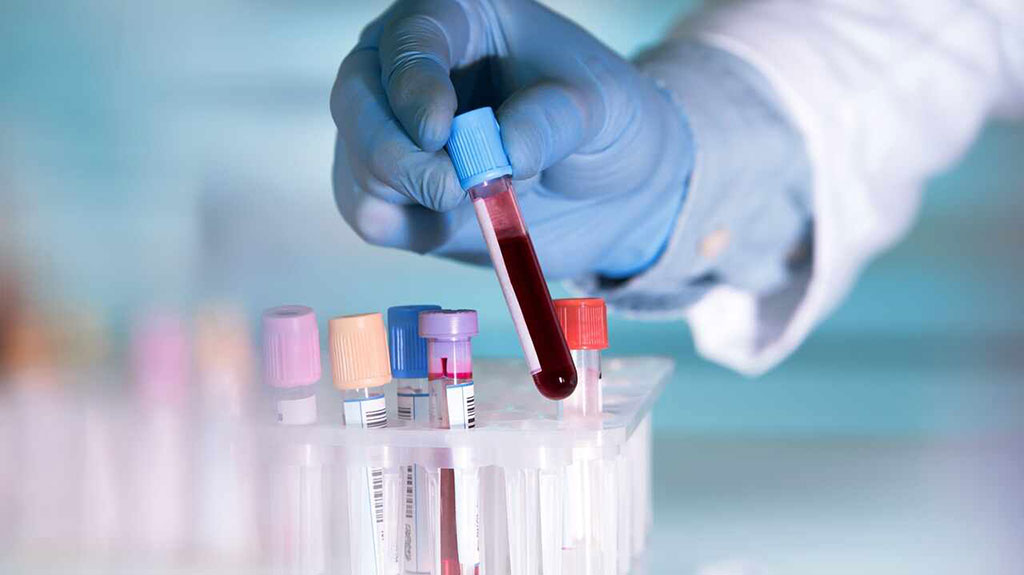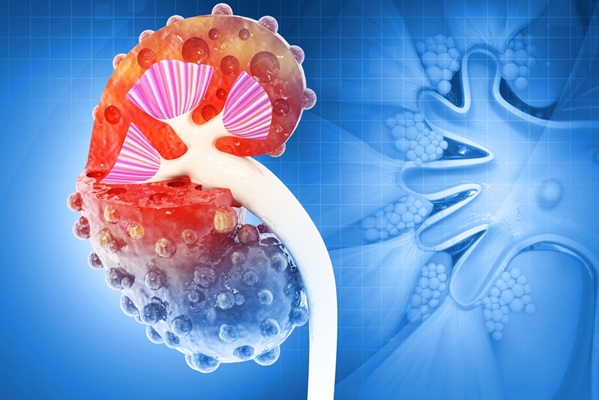Blood Test Can Determine Liver Disease Progression
|
By LabMedica International staff writers Posted on 22 Jun 2022 |

Non-alcoholic fatty liver disease (NAFLD) is one of the most common chronic liver diseases worldwide and is estimated to affect about 30% of the European population. Chronic non-alcoholic fatty liver disease can develop into irreversible liver cirrhosis, which can only be cured by liver transplantation. Therefore, it is particularly important to identify patients with non-alcoholic fatty liver disease early on. Now, researchers have identified the role of a specific subtype of macrophages (white blood cells) in progressive NAFLD. As part of the immune system, these cells have a protective function against fibrosis and liver cirrhosis. At the same time, they are useful as biomarkers of liver disease progression as they can be measured by a blood test.
The pathogenesis (development) of NAFLD, especially advanced steatohepatitis (NASH, also: non-alcoholic fatty liver hepatitis), is associated with profound changes in immune cells in the liver. Recently, the increased accumulation of a subtype of macrophages that express high levels of the receptor TREM2 has been described in fatty liver disease. However, the role of TREM2-positive macrophages in non-alcoholic fatty liver disease was hitherto unknown. Now, researchers at Medical University Vienna (Vienna, Austria) have shown in an animal model that these specific macrophages have a protective function in fibrosis - a precursor to liver cirrhosis. These cells are found in greater numbers in the affected areas of the liver upon NAFLD-associated liver inflammation, where they accumulate particularly in areas of cellular damage and fibrosis.
TREM2 exists both as a membrane receptor on cells as well as a soluble form (sTREM2) that is detectable in blood. The role of this soluble form in the immune system is not yet clear. However, the researchers discovered that it is useful in patients for determining the current status of the disease and helps to distinguish between the different stages of fatty liver hepatitis much better than previously known biomarkers used in clinical practice. The researchers also demonstrated in bone marrow transplantation models that hematopoietic TREM2 deficiency prevents efficient fat storage and breakdown of excess connective tissue (extracellular matrix), leading to increased steatohepatitis, cell death and fibrosis. Hence, TREM2-positive macrophages fulfill an important protective function in NAFLD, where they prevent fat accumulation, inflammatory processes and progression of the disease to liver fibrosis.
"It may be possible to develop new therapeutic approaches to treat fatty liver hepatitis by enhancing this protective function of TREM2-positive macrophages," said Florentina Porsch, co-first author of the study.
"The soluble form of TREM2 is an excellent biomarker for identifying and staging advanced liver disease, which can progress from fatty liver disease to incurable cirrhosis if left untreated," added first author Tim Hendrikx from MedUni Vienna's Department of Laboratory Medicine.
Related Links:
Medical University Vienna
Latest Molecular Diagnostics News
- Routine Blood Draws Could Detect Epigenetic Biomarkers for Predicting Cardiovascular Disease Risk
- Single Cell RNA Sequencing Could Enable Non-Invasive Blood Disorder Diagnosis
- Blood Test Identifies HPV-Associated Head and Neck Cancers 10 Years Before Symptoms
- Giant DNA Elements Discovered in Mouth Could Impact Oral Health
- Simple Blood Test Spots Disease Through Metabolic Distortion
- Simple Blood Test Could Streamline Early Alzheimer's Detection
- Unique Microbial Fingerprint to Improve Diagnosis of Colorectal Cancer
- ELISA-Based Test Uses Gynecologic Fluids to Detect Endometrial Cancer
- Comprehensive Tumor Profiling Kit Decentralizes and Standardizes Oncology Testing
- Automated Syndromic Testing System Combines Unparalleled Throughput with Simple Workflow
- Simple Urine Test Assesses Risk of Kidney Cancer Recurrence at Early Stage
- Molecular Map Reveals Previously Hidden Connections Between Diseases
- Novel Urine-Based Test Detects Prostate Cancers
- MRD Testing Can Identify Breast Cancer Survivors at Higher Risk of Recurrence
- Cytoskeletal Protein Linked to Cervical Cancer Growth Paves Way for Precise Diagnostic Tools
- Molecular Allergy Chip Detects Allergic Asthma in Individual Patients
Channels
Clinical Chemistry
view channel
Gold Nanoparticles to Improve Accuracy of Ovarian Cancer Diagnosis
Ovarian cancer is considered one of the deadliest cancers, in part because it rarely shows clear symptoms in its early stages, and diagnosis is often complex. Current approaches make it difficult to accurately... Read more
Simultaneous Cell Isolation Technology Improves Cancer Diagnostic Accuracy
Accurate cancer diagnosis remains a challenge, as liquid biopsy techniques often fail to capture the complexity of tumor biology. Traditional systems for isolating circulating tumor cells (CTCs) vary in... Read moreHematology
view channel
Pioneering Model Measures Radiation Exposure in Blood for Precise Cancer Treatments
Scientists have long focused on protecting organs near tumors during radiotherapy, but blood — a vital, circulating tissue — has largely been excluded from dose calculations. Each blood cell passing through... Read more
Platelets Could Improve Early and Minimally Invasive Detection of Cancer
Platelets are widely recognized for their role in blood clotting and scab formation, but they also play a crucial role in immune defense by detecting pathogens and recruiting immune cells.... Read more
Portable and Disposable Device Obtains Platelet-Rich Plasma Without Complex Equipment
Platelet-rich plasma (PRP) plays a crucial role in regenerative medicine due to its ability to accelerate healing and repair tissue. However, obtaining PRP traditionally requires expensive centrifugation... Read moreImmunology
view channel
Companion Diagnostic Test Identifies HER2-Ultralow Breast Cancer and Biliary Tract Cancer Patients
Breast cancer is the most common cancer in Europe, with more than 564,000 new cases and 145,000 deaths annually. Metastatic breast cancer is rising in younger populations and remains the leading cause... Read more
Novel Multiplex Assay Supports Diagnosis of Autoimmune Vasculitis
Autoimmune vasculitis and related conditions are difficult to diagnose quickly and accurately, often requiring multiple tests to confirm the presence of specific autoantibodies. Traditional methods can... Read more
Blood Test Predicts Immunotherapy Efficacy in Triple-Negative Breast Cancer
Triple-negative breast cancer (TNBC) is an aggressive subtype lacking targeted therapies, making immunotherapy a promising yet unpredictable option. Current biomarkers such as PD-L1 expression or tumor... Read more
Simple Genetic Testing Could Predict Treatment Success in Multiple Sclerosis Patients
Multiple sclerosis (MS) patients starting therapy often face a choice between interferon beta and glatiramer acetate, two equally established and well-tolerated first-line treatments. Until now, the decision... Read moreMicrobiology
view channel
Microfluidic Platform Assesses Neutrophil Function in Sepsis Patients
Sepsis arises from infection and immune dysregulation, with neutrophils playing a central role in its progression. However, current clinical tools are unable to both isolate these cells and assess their... Read moreNew Diagnostic Method Confirms Sepsis Infections Earlier
Sepsis remains one of the most dangerous medical emergencies, often progressing rapidly and becoming fatal without timely intervention. Each hour of delayed treatment in septic shock reduces patient survival... Read more
New Markers Could Predict Risk of Severe Chlamydia Infection
Chlamydia trachomatis is a common sexually transmitted infection that can cause pelvic inflammatory disease, infertility, and other reproductive complications when it spreads to the upper genital tract.... Read more
Portable Spectroscopy Rapidly and Noninvasively Detects Bacterial Species in Vaginal Fluid
Vaginal health depends on maintaining a balanced microbiome, particularly certain Lactobacillus species. Disruption of this balance, known as dysbiosis, can increase risks of infection, pregnancy complications,... Read morePathology
view channelAccurate Pathological Analysis Improves Treatment Outcomes for Adult Fibrosarcoma
Adult fibrosarcoma is a rare and highly aggressive malignancy that develops in connective tissue and often affects the limbs, trunk, or head and neck region. Diagnosis is complex because tumors can mimic... Read more
Clinicopathologic Study Supports Exclusion of Cervical Serous Carcinoma from WHO Classification
High-grade serous carcinoma is a rare diagnosis in cervical biopsies and can be difficult to distinguish from other tumor types. Cervical serous carcinoma is no longer recognized as a primary cervical... Read moreTechnology
view channel
Coral-Inspired Capsule Samples Hidden Bacteria from Small Intestine
The gut microbiome has been linked to conditions ranging from immune disorders to mental health, yet conventional stool tests often fail to capture bacterial populations in the small intestine.... Read more
Rapid Diagnostic Technology Utilizes Breath Samples to Detect Lower Respiratory Tract Infections
Respiratory tract infections (LRTIs) are leading causes of illness and death worldwide, particularly among vulnerable populations such as the elderly, young children, and those with compromised immune systems.... Read moreIndustry
view channel
Werfen and VolitionRx Partner to Advance Diagnostic Testing for Antiphospholipid Syndrome
Antiphospholipid syndrome (APS) is a rare autoimmune disorder that causes the immune system to produce abnormal antibodies, making the blood “stickier” than normal. This condition increases the risk of... Read more



















